The township of Huyton is one of ancient origin. In the Domesday survey of 1086 the name of the settlement appeared as Hitune meaning literally ‘High Town’ and was held, together with the manor of Torboc (Tarbock), by a local lord named Dot. These manor lands were a portion of the area between the Ribble and the Mersey known collectively as the West Derby Hundred. The spelling of the township’s name varied from Hitune (1086); Houton (1258); to Hyton and Huyton (1292), the latter becoming the recognised spelling from 1300 onwards.
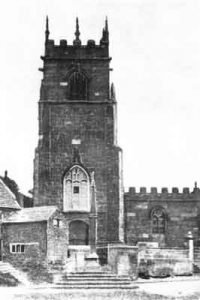
The focal point of Huyton is the historic Parish Church dedicated to St. Michael which stands (as many churches of this name), occupying high ground on a ridge and therefore visible throughout the township. There may have originally been a Saxon church on this site but a church certainly existed here in the 12th Century for it was granted to the Priory of Burscough, by Robert, son of Henry de Lathom (whose family are remembered by the present-day Lathom Road). The present church building is of medieval origin, which, despite having been subsequently altered over many centuries, retains notable features of various different periods. Within the church is an early Norman font found buried under the Tower in 1872. A second font of octagonal design and a rood screen, which date from the 15th Century, were added later. The list of past clergy begins with Richard de Walton who was rector in 1254.
In the 14th Century, the lordship of the ‘de Lathom’ lands including Huyton, Roby and Knowsley, changed to the Stanley family by marriage. In 1485, Thomas, Lord Stanley, became the first Earl of Derby, a title given to him by Henry VII in appreciation for the Stanley family’s support at the Battle of Bosworth. Also around this time the Harrington family acquired the tenancy of the manor of Huyton Hey by marriage. From that time the two families were to figure heavily in Huyton’s future.
The descent of the Harringtons remained supporters of the Catholic faith throughout the Reformation period. However, due to broken lines of descent, the manor of Huyton Hey passed to the Molyneux family, later becoming Molyneux-Seel through the female line. A portion of the Molyneux-Seel land namely Huyton Hey Manor farm on Huyton Hey Road, is the township’s oldest surviving secular building. Originally with a datestone of 1670, it was renovated and enlarged, and now houses a residential care home of the same name. Adjacent to Huyton Hey Manor is a small park area called Paradise, which was made into a children’s playground by the council after the land was donated by Lady Carr-Saunders (formerly Molyneux-Seel).
With changing industrial development during the 19th Century, the area of Huyton Quarry expanded rapidly. Quarrying took place here, as did coal mining; the area at various times boasted a coarse earthenware pottery, an iron works, a gas works, a blue works, an electric lamp works and later a chairmaking factory. Short streets of terraced housing were built throughout this portion of the township to accommodate the workforce.

Other places of worship appeared during the 19th Century. In 1856, a Huyton Congregational Church was built in Huyton Hey Road, with an attached school completed in 1861.

In 1890, a larger congregational church at the junction of Victoria Road and Seel Road was built.

Similarly, the original Roman Catholic Chapel of St. Agnes of 1856, was replaced by a modern style structure completed in 1965.
Railway transport brought inevitable change to the area following the success of Stephenson’s Rocket at the nearby Rainhill Trials and the subsequent development of the Liverpool to Manchester Railway in 1830s.
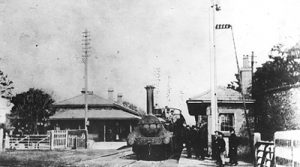
Huyton Railway Station (formerly Huyton Gate Station) remains today a vital link in the local transport system. Following major refurbishment and with all four rail lines now back in use, together with the introduction of electrification to the local network, rail travel is as busy as it ever was but now quieter and more efficient.
Although much of old Huyton village was pulled down in the 1960s to make way for road widening and a shopping centre, there are still buildings of note remaining within other parts of the township.
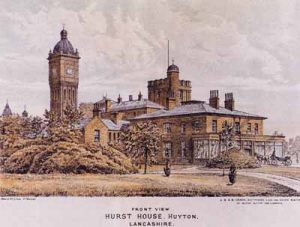
These buildings include Hurst House, off Huyton Lane, built around 1830 (this building became the clubhouse of a local golf club in 1905) and The Hazels, off Liverpool Road, an impressive red brick house of 1764, which during the 19th Century was home for members of the Pilkington family, the glass-makers of St. Helens. Following the Second World War, it became part of the C. F. Mott Teacher Training College. The C. F. Mott site was eventually redeveloped, with the Hazels now at the entrance to a large business park complex.
Liverpool College for Girls, Huyton (later known by its shortened name Huyton College) opened in 1894 with just a small number of pupils, but soon became very popular and by its heyday, had expanded dramatically from its central base containing the houses of Huyton Hall and Fernwood (located close to Huyton Railway Station), to having numerous boarders living in outlying Victorian villas in ‘The Orchard’ and St. Mary’s Road.
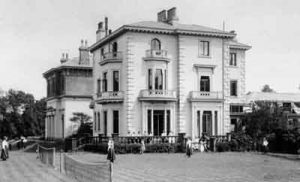
Many of these properties dating from 1850s were formerly occupied by merchants and ship owners. Sadly, Huyton College closed in 1993, the main grounds now occupied by residential housing.
Some other surviving historical buildings have been used as residential homes for the elderly for decades, including Yewtree, on Roby Road, which became St. Helena’s but is now called Helena’s House and Manor Farm (onetime home of the Molyneux-Seel family) which now greatly extended, operates as Huyton Hey Manor.
The Beecham family resided for many years in Huyton. Their estate encompassed the area now occupied by Blacklow Brow, The Rooley, and part of Tarbock Road. Their residence, Ewanville, was occupied by members of the family between 1885-1928. A few years later, the estate was sold and developed.
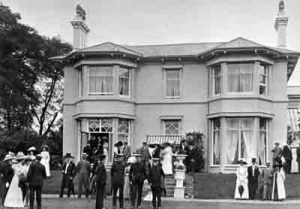
During the Second World War, some houses in the Jefferey’s Crescent area around Page Moss and the Coronation Drive and Reva Road area in Swanside were damaged by bombing which took place from late 1940, up to the ‘May Blitz’ of 1941 during which, a number of civilians were killed. Also, early in the war, an internment camp was set up in Huyton to house German and Austrian nationals who had been detained for fear of collaboration and spying. They were placed in unoccupied council housing at Page Moss where a number of streets had been fenced off with barbed wire. The internment camp at Huyton was only temporary with most detainees being moved on after a short period to Douglas, Isle of Man.
Huyton also had a Prisoner-of-War camp during the Second World War, located on King George V playing fields on Longview Lane. The camp remained open for a few years after the war with some former prisoners taking part in bomb-disposal work with the Royal Engineers. A small number of prisoners did not return home to their native country but met and married local women and settled locally.


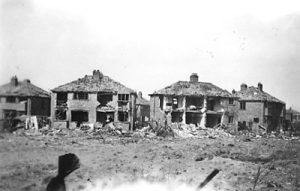
Huyton’s population increased from 1930s when land owned by Lord Derby was sold to Liverpool Corporation, bringing in a large number of new residents.
Housing estates, mostly post-war, appeared over a wide area and this increase in population required changes to Huyton-with-Roby’s infrastructure. Redevelopment took place around the Derby Road and Archway Road area which included road alterations and the demolition of many old structures such as the old Infant School building and bank building, as Huyton Village was transformed into a modern town centre. The Prescot and Huyton Reporter supplement of 18th November 1966 featured the redevelopment. A copy of the supplement, donated to the Archive by Mr. Taylor of Huyton, can be read here: Prescot Reporter Supplement 18 Nov 1966 – Huyton Town Centre Redevelopment
During 1970s, shopping habits changed dramatically around the country and in Huyton Village, Asda opened its large store at the north end of Derby Road on 8th November 1977 at a cost of £1.5 million. This trend of building larger and larger stores continued nationally and on 28th August 2005 Asda Wal-Mart opened its two-storey superstore off Huyton Lane, the former Asda store being demolished.


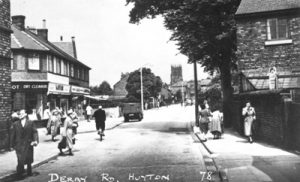
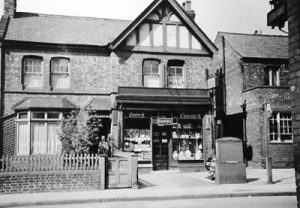
The visual change in Huyton Village is evident through a study of old photographs of Derby Road taken from 1870s – 1977 before it was pedestrianised.
As Huyton’s old buildings disappeared, new buildings started to appear including The Huyton Suite which was officially opened by Harold Wilson on 5th April 1975. The Library Service moved from the old Carnegie library in Westmorland Road to the new Huyton Central Library building at the top of Derby Road, officially opened by Lady Mary Wilson in April 1978.
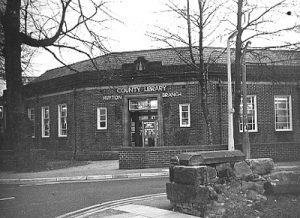

The Derby Road library building itself was eventually demolished but a brand new Huyton Library and Gallery opened in August 1997 in Civic Way (officially opened in 1998), next door to the Huyton Suite (later re-named The Venue).
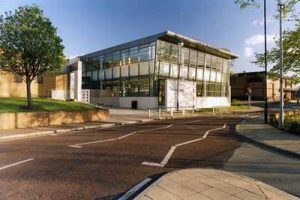
Another landmark to disappear was the Victorian period Nutgrove Villa in Derby Road. However, the Nutgrove Villa name lives on with the busy Knowsley NHS Walk-in Centre (built on the site of the old 1930s library building, Westmorland Road) which opened in December 2005.

Secondary education in the borough has been streamlined in recent years with the introduction of academy schools. In 2009 Knowsley Hey High School merged with Bowring Comprehensive School and a new school was built on the former Knowsley Hey site in Seel Road (under the Building Schools for the Future programme). The new school was named Huyton Sports and Arts Centre for Learning. In 2014, this academy school undertook a change of name and is now known as the Lord Derby Academy.
Following consultation with residents, a masterplan for the future development of Huyton Village was published by Knowsley Council in 2017.
A new event began in Derby Road, Huyton, in June 2018 with ‘Foodie Friday’, featuring street food traders and live entertainment, which proved a great success.
A new modern look to the shopping centre of Huyton Village began in 2019 when a number of new shops and restaurants opened and this was enhanced by a phased transformation of shop fronts in Derby Road. Turkish and Mediterranean restaurant Eaton Place opened in February; independent coffee shop The Coffee House opened in Derby Road in December, as did Hays Travel (located in the former Thomas Cook shop).
Another familiar landmark disappeared from Huyton Village in May when Huyton’s former Fire Station and its ancillary buildings off Huyton Lane, were demolished. A replacement community fire station was opened in Prescot in 2018 covering the townships of Prescot, Huyton and Whiston.
The popular ‘Foodie Friday‘ events restarted in June 2019 but under the new name ‘Huyton Live‘.
Tapas restaurant El Pueblo opened in January 2020 and was followed by restaurant and bar Common (located in the former Westminster Bank building) in September.
The Coronavirus pandemic in 2020 dominated the news for the whole year. A timeline of the events that occurred can be consulted here: COVID-19 National and Local timeline 2020
After much speculation, The Venue in Civic Way (formerly The Huyton Suite) officially closed on 1st January 2021 having been open since 1975.
Two Huyton community projects and one in Stockbridge Village are to contribute towards net carbon zero for the Liverpool City Region by 2040. The successful projects gained support from the Liverpool City Region’s Community Environment Fund. The Huyton projects being St. Gabriel’s Church Community Garden, Huyton Quarry and The Old School House Community Project, St John’s Road. The successful candidates were announced in February 2021.
Also in February 2021, The Lord Derby Academy in Huyton achieved its goal when inspectors rated it with Inclusion Quality Mark – ‘Centre of Excellence’ status, in promoting equal opportunities and high ambitions for all its pupils.
Work was completed in March 2021 on the installation of 18 CCTV cameras providing full coverage throughout Huyton Village centre, following investment by Knowsley Council. During the same month, real-estate developer Network Space Limited acquired the 28-acre former Sovereign Distillery site of Halewood International on Wilson Road.
Two-storey Italian restaurant La Vita opened in Derby Road in June, providing yet another option for local diners.
During July, work began on the demolition of The Venue building in Civic Way. The location had been the social centre of Huyton Village for 45 years.
The annual remembrance service and the laying of wreaths, organised by members of the Royal British Legion took place at the Huyton Cenotaph, Civic Way, on Thursday 11th November starting at 10.45am.
Friday 19th November saw the usual Huyton Live event in Huyton village centre featuring food and drink, live music and walkabout entertainment, but also included the switching on of the 2021 Christmas lights. The event ran from 4pm till 9pm.
A ‘pop-up’ Christmas cinema was erected in a marquee in Derby Road, Huyton Village and showed four different festive films each day during the weekend of Friday 10th, Saturday 11th and Sunday 12th of December. The films were shown at 12 midday, 2.30pm, 5pm and 8pm daily.
As the Coronavirus pandemic continued in 2021 with new variants appearing, a further timeline shows the changing situation throughout the year: COVID-19 National and Local timeline 2021
Also in late 2021, under the long-term masterplan for the transformation of Huyton Village, the pre-fabricated Yorkon building (an out-of-date council premises adjacent to the Municipal Buildings) was removed section by section.
As Knowsley is the Liverpool City Region’s Borough of Culture for 2022, events will be happening all year in celebration. From 12th – 26th February celebrated artists Squid Soup will be presenting two light installations in Huyton Village centre. The first called Submergence a light-illusion artwork will be situated in Sherbourne Square and is a walk-through experience containing thousands of individual points of suspended light. The second titled Singularity is described as a sphere of light and movement and each will be illuminated between 5pm and 10pm daily.
Sir George Howarth, M.P. for the Knowsley Constituency received the honour of Freedom of the Borough at a Knowsley Council meeting on 23rd March. The long-serving Labour M.P. began his political life as a councillor for Huyton-with-Roby Urban District Council in the 1970s, before becoming an M.P. in 1986.
New businesses continue to appear around the town centre as two more restaurants opened in Derby Road in February 2022: the Solasta Steakhouse and Floga, offering Greek cuisine and during May, the discount retailer B&M opened its new larger store in Cavendish Walk.
Also in May, another council initiative brought about the illumination at night of the internal arch of the Archway Road railway bridge with a palette of 32 coloured LED lights.
June 2022 saw the opening of a new menswear shop called Suitable Attire in Sherborne Square.
To provide support to Knowsley Borough residents during the winter months, all library buildings in the borough are to become Warm Hubs from 1st November 2022 till the end of March 2023.
The success of the UK’s vaccination programme meant that coronavirus restrictions were eased in 2022. A summary of COVID-19 information for the year can be found here: COVID-19 National and Local timeline 2022
Knowsley Council recently submitted three bids for funding under Round 2 of the Government’s Levelling Up Fund – one each for the townships of Huyton, Halewood and Prescot. One of the bids, for £20 million was to accelerate the council’s 10-year plan to transform Huyton Village centre. A government announcement on 18th January 2023 listed the successful applicants: unfortunately, both the Huyton and Prescot bids failed to gain any funding but the bid for Halewood township was successful and was awarded £15.3m.
The UK Government’s Emergency Alerts System is now live and will be used to warn people when lives are in danger, initially to warn of severe weather-related incidents including flooding and provide instructions how to respond to an alert. To check the system, a test took place at 3pm on Sunday 23rd April whereby most people received an official text message on their mobile phones.
The latest COVID-19 information can be found here: COVID-19 National and Local timeline 2023 (to end of May 2023)
